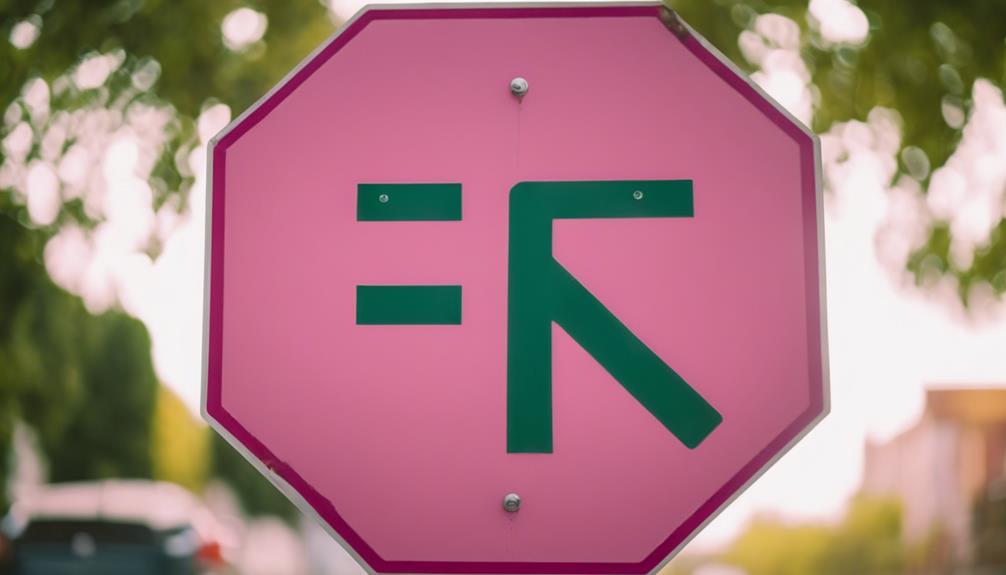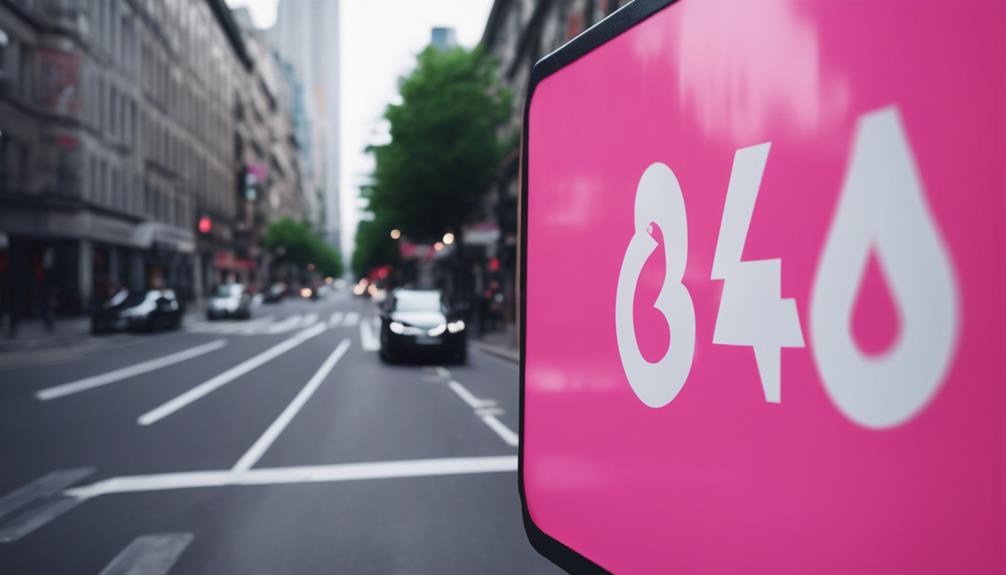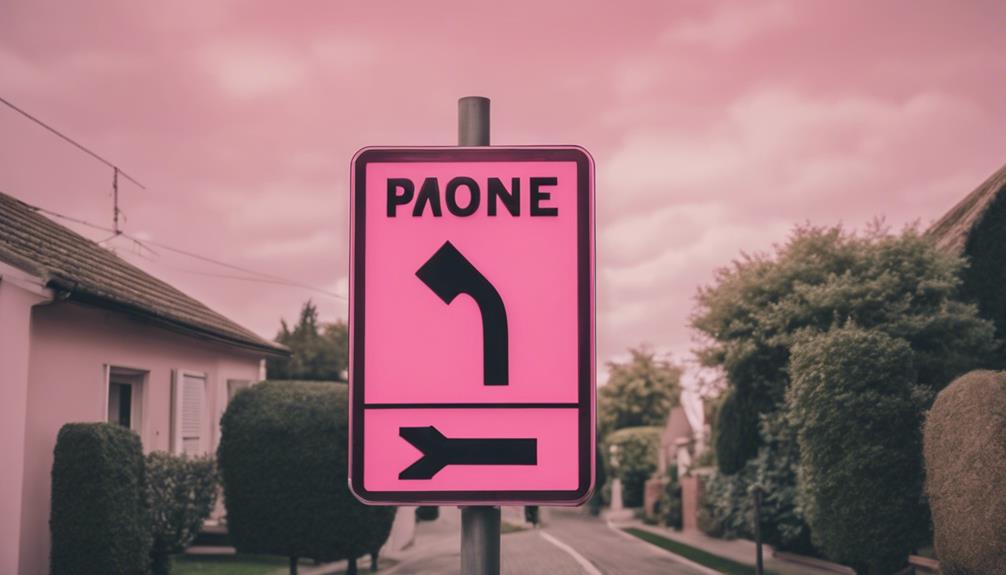Pink road signs are vital for incident management, designed in a vivid color to grab immediate attention. They convey warnings or directions during unexpected or emergency situations on the road. These signs enhance driver awareness and promote road safety by providing important information quickly. Understanding their meanings can help drivers navigate hazardous conditions and react appropriately to changing road circumstances. Keep in mind that these signs are strategically placed to alert drivers effectively and guarantee safe navigation. Learning more about the significance and regulations of pink road signs can further enhance your understanding of their importance in keeping road users safe.
Key Takeaways
- Pink road signs signify temporary hazards or unexpected conditions.
- They alert drivers to be cautious and prepared for immediate attention.
- Designed for incident management to ensure road safety.
- Communicate critical information during emergencies or unforeseen events.
- Serve as a warning for potential dangers and require driver attention.
Importance of Pink Road Signs
Pink road signs hold significant importance in ensuring road safety during unexpected incidents, serving as crucial tools for guiding drivers through unplanned events. These signs stand out due to their vivid pink color and are designed with specific shapes and symbols to convey important messages to drivers. The unique color choice of fluorescent pink is intentional to grab drivers' attention and alert them to temporary changes or hazards on the road.
Road signs come in various colors and shapes, each serving a different purpose. Pink signs are particularly used for incident management, indicating detours, closures, or other necessary information. The contrast of black symbols or text against the pink background enhances visibility, ensuring that drivers can quickly comprehend the message conveyed by the sign.
Understanding the significance of pink road signs is essential for all drivers, as it helps them navigate through incident-prone areas more cautiously and be prepared for unexpected road conditions. By being aware of the meanings behind different colors and shapes of road signs, drivers can contribute to enhancing overall road safety.
Visibility and Recognition of Pink Signs

Pink road signs serve an essential purpose in guiding drivers during unexpected events. Their vivid pink color and black symbols make them easily recognizable from a distance.
While pink signs aren't as common as traditional road signs, they're highly effective in capturing attention and prompting caution on the road.
Pink Sign Purpose
While driving on the road, one can't overlook the importance of recognizing and understanding the purpose behind vividly colored signs that stand out to guide us through unexpected incidents.
Pink road signs are specifically used for incident management, such as accidents or other unplanned events. The striking pink color is selected to make sure these signs grab the attention of drivers on the road, standing out among other traditional road signs. Unlike other colors with specific meanings, pink signs are essential for directing drivers and emergency responders to effectively handle unforeseen situations.
When encountering a pink road sign, drivers should be prepared to follow instructions related to incident management or emergency protocols to guarantee safety and efficient management of the situation.
Color for Attention
Enhancing visibility on the road, the striking pink color of road signs plays a vital role in grabbing immediate attention and alerting drivers to potential dangers during unplanned incidents. When it comes to warning signs, using high-quality colors is essential for ensuring safety on the roads.
Here are three key points to keep in mind regarding the visibility and recognition of pink signs:
- Vivid Colors: Pink signs, in combination with black symbols or text, stand out against the backdrop of the road, making them easily noticeable.
- Universal Understanding: While pink signs don't have specific meanings like other colors, they universally convey the need for caution and increased awareness.
- Strategic Design: The use of fluorescent pink is intentional, as it distinguishes itself from traditional colors, ensuring critical information gets immediate attention.
Uncommon but Effective
For drivers on the road, encountering pink signs signifies the presence of unexpected or emergency conditions that demand immediate attention and caution. Pink road signs are an important indicator of incident management, especially for unplanned events like accidents. The vivid pink color with black symbols enhances visibility and recognition, ensuring quick awareness for drivers.
Despite being rare, pink signs stand out on the road to signal temporary situations that require immediate attention and caution. When drivers see these pink signs, they should be prepared to adjust their driving behavior for safety and navigate around incident areas. This unique use of pink as a warning color effectively draws attention to emergency conditions, making it a valuable tool for ensuring road safety.
Pink Sign Design and Meaning

Let's talk about the design and meaning of pink road signs. Understanding the color symbolism in signs and following pink sign regulations are essential for safe driving.
Color Symbolism in Signs
How do pink road signs effectively communicate important information to drivers during unexpected incidents? Pink road signs, specifically designed for incident management, play a vital role in alerting drivers to unforeseen events on the road. Here are three key ways in which the color symbolism of pink signs enhances communication during emergencies:
- Distinct Visibility: The fluorescent pink color stands out vividly against the backdrop of other road signs, ensuring that drivers quickly notice and comprehend the message.
- Unique Recognition: Pink road signs aren't commonly used, making them easily recognizable in critical situations, prompting immediate attention and response.
- Clear Guidance: By providing clear and concise information during incidents, pink signs help drivers navigate safely through unexpected events, contributing to overall road safety.
Pink Sign Regulations
After examining the significance of pink road signs in enhancing communication during emergencies, it's essential to understand the regulations surrounding their design and meaning.
Pink road signs are specifically used for incident management, indicating unplanned events like accidents. The color pink on road signs is designated to signal temporary situations that require driver attention. These fluorescent pink signs stand out on the road, ensuring they're easily recognizable for drivers.
When drivers encounter pink road signs, they should be prepared for incident-related information or instructions. Understanding these regulations is vital for effective incident management and ensuring safety on the road during unexpected events.
Pink Signs for Incident Management

Pink signs for incident management play an important role in alerting drivers to potential hazards and directing traffic effectively during unplanned events like accidents. These signs are essential for ensuring road safety and facilitating smooth traffic flow in challenging situations. Here are three key functions of pink signs for incident management:
- Warning of Hazards: Pink signs with black symbols stand out conspicuously, warning drivers of possible dangers ahead. This visual alertness helps drivers anticipate and react appropriately to hazards, reducing the risk of accidents.
- Guiding Traffic: Pink signs help in directing traffic away from the incident site or towards alternative routes. By following the instructions on these signs, drivers can navigate through the affected area safely and efficiently.
- Communicating Temporary Information: During incidents or road closures, pink signs provide essential temporary information to drivers. This communication is crucial for keeping drivers informed and ensuring they make informed decisions while on the road. Understanding and following pink signs is important for maintaining road safety during unexpected events.
Safety Measures With Pink Signs

Implementing safety measures with pink signs involves ensuring drivers are adequately informed and guided during unexpected road incidents. Pink signs are essential for incident management, signaling to drivers the presence of potential hazards such as road work ahead or construction zones. When encountering pink signs, it's important for drivers to remain vigilant and follow any instructions provided.
These signs are designed to alert drivers to temporary changes in road conditions, such as detours or road closures, allowing for safe navigation through these areas. By understanding the purpose of pink signs and acknowledging their significance, drivers can proactively respond to changing or hazardous situations on the road.
Understanding Pink Sign Placement

When encountering pink signs on the road, our attention is drawn to their placement, guiding us through unexpected situations and promoting safe navigation. Understanding where these pink signs are positioned is vital for drivers to respond appropriately.
- Near Schools: Pink road signs are often placed near school zones to alert drivers of the presence of children crossing or walking along the road. These signs serve as a warning to proceed with caution and follow reduced speed limits in these areas.
- Around School Buses: Pink signs may also be strategically placed around school buses to indicate areas where children are boarding or alighting. Drivers should be vigilant when approaching school buses displaying pink signs to prevent accidents and safeguard the safety of students.
- On Temporary Road Constructions: Pink signs can be found near temporary road constructions or detours to provide directions and signal potential hazards. It's essential for drivers to follow the instructions on these signs to navigate safely through the altered roadways.
Regulations for Pink Road Signs

Regulations governing the use of pink road signs outline specific guidelines for their placement and significance in various roadway scenarios. Pink road signs, with their vital color and black symbols or text, serve as indicators of important information for drivers.
The shapes and colors of road signs are essential elements in conveying specific messages to motorists. When encountering pink road signs, drivers must be attentive and prepared to adjust their driving behavior accordingly.
These signs are primarily used for incident management at unplanned events such as accidents, temporary construction zones, road closures, and detours. While pink road signs alert drivers to potential hazards or changes in the road conditions, they typically don't mandate speed adjustments unless explicitly stated for safety reasons.
Understanding the regulations for pink road signs is necessary for ensuring road safety and effective communication between road authorities and drivers. Remember to stay vigilant and responsive when encountering these vividly colored signs on the road.
Pink Signs and Driver Awareness

Moving from regulations regarding pink road signs, let's now focus on the significance of pink signs and how they heighten driver awareness on the road.
Pink road signs serve as an important element in guiding and alerting drivers to unexpected events, especially during emergencies. Here are three key points to keep in mind:
- Distinct Color for Immediate Attention: The vibrant pink color of these signs stands out from the typical road signs, signaling a need for heightened caution and attention from drivers. This notable color choice ensures that drivers quickly notice and process the information presented on the pink signs.
- Guidance to Drivers: Pink road signs provide essential direction to drivers, guiding them on how to navigate through unplanned incidents like accidents. By following the instructions on these signs, drivers can effectively manage emergencies and contribute to overall road safety.
- Enhanced Driver Awareness: Understanding the purpose and significance of pink road signs enhances driver awareness on the road. Being mindful of these signs helps drivers respond promptly and appropriately to unforeseen events, ultimately improving road safety for all.
Frequently Asked Questions
What Are the 8 Colors Used for Road Signs?
There are 8 colors used for road signs. Each color serves a specific purpose in conveying important information to drivers. Understanding these colors is vital for safe driving.
From red for stop and green for go, to yellow for caution and blue for services, each color helps us navigate the roads effectively. Mastering these color codes is essential for all drivers to guarantee safety and efficient travel on the roadways.
What Does Pink on the Street Mean?
When we encounter pink on the street, it's important to grasp its significance. Pink road signs are crucial for incident management, like accidents, providing essential guidance in unexpected situations.
These vivid signs with black symbols indicate temporary road closures, detours, or other incident-related information. It's important to pay attention and follow instructions for the safety of all. Failure to comply with these signs can result in accidents or penalties. Understanding the meaning of triangle road signs is also crucial, as they often indicate warnings such as yield, caution, or upcoming hazards. Always remain alert and adjust your driving accordingly to ensure a smooth and safe journey for everyone.
Understanding pink road signs helps drivers navigate through hazards effectively.
What Do the Different Colour Road Signs Mean?
When it comes to road signs, understanding their different colors is important for safe driving. Each color conveys a specific message, guiding us on the road.
From red indicating stop to yellow warning us to slow down, these colors play a significant role in communicating important information to drivers.
What Does a Purple Road Sign Mean?
Purple road signs typically indicate specific regulations or guidance for a particular area. These signs often convey information related to parking restrictions, bus lanes, or other local rules that drivers need to follow.
Understanding the meaning of purple road signs is vital for traversing urban areas and complying with local ordinances. Paying attention to these signs helps guarantee safety and adherence to traffic laws.
Always be vigilant and observant of all road signs to avoid any violations or accidents.
Conclusion
To sum up, pink road signs play a crucial role in guiding drivers and promoting safety on the road. By grasping the design, meaning, and placement of these signs, drivers can enhance their ability to navigate their surroundings and react to potential hazards.
Keep in mind, always stay vigilant and adhere to the regulations established for pink road signs to guarantee a smooth and secure journey on the road. Stay informed, stay safe!









